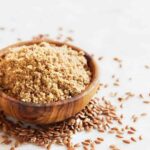3 Healthy Alternatives to Chips

As much as you may love green smoothies, there are always going to be those times when you’re craving some crunchy chips.
While they taste great at the moment, they usually leave you with a family-sized helping of eater’s remorse – and a generous side of belly bloat to go with it.
Luckily, it doesn’t have to be that way! You can incorporate crispy chips into your healthy eating plan, right alongside your green smoothies.
In fact, these healthy chip alternatives are just as nutritious as they are satisfying and delicious.
One of my favorite lunches is a quart of green smoothie and these chips with a side of guacamole mixed with salsa!
[Sprouted, ground seeds can be excellent ingredients to use in healthy chip alternatives – plus so much more, including daily green smoothies. Save Up to 25% Off Our Sprouted Seeds in July Only.]
In this article:
- Easy Baked Pita Chips Recipe
- Sprouted Tortilla Chips Recipe
- Cilantro-Corn Flaxseed Tortilla Chips Recipe
Is your curiosity piqued? Are you ready to change your snacking style?
Read on for three healthy alternative chips, so you'll never feel bad about indulging again.
Easy Baked Pita Chips Recipe
Your first option for making healthy chips at home is to bake your own pita chips.
They’re quick, easy, and crunchy, and they're a good alternative to fried chips.
Start by buying a package of organic, whole-grain pita bread – and be sure to check the ingredients and look for a product that says “100% whole wheat" or "100% whole grain.” If it simply says “whole wheat,” it legally still may have white flour as the first ingredient.
While “gluten-free” is all the rage these days, and represents $16 billion in products, wheat can actually be good for you, according to many worldwide studies – as long as it’s organic and whole-grain (and you don't have Celiac disease or a true gluten sensitivity).
(More and more nutrition experts realize that it isn’t always gluten that’s the problem unless you have Celiac disease – it’s more likely to be the Roundup sprayed twice on non-organic wheat, plus hybridization of non-organic wheat, and maybe other additives in wheat products.)
Eating 100% organic, whole-grain foods (especially sprouted and not made from flour) is a proven way to boost your nutrition.
Research shows that products that include all three parts of whole grain kernels – the bran, germ, and endosperm – are rich in vitamins and minerals.1 Whole grain also is a good source of many phytochemicals that are believed to play a role in disease prevention.2
The benefits of eating whole grain products may include:3
- lower cholesterol
- steady blood sugar
- lower risk of blood clot formation that may cause heart attacks or strokes
- protection from some cancers

Reaping all of these whole food benefits is easy and delicious with homemade pita chips.
This tasty alternative to chips takes just a few minutes and results in a tasty alternative to fried corn or potato chips.
Just follow these steps:
Easy Baked Pita Chips
- Turn on your broiler to 450.
- Take your package of organic 100% whole grain pita pockets and cut each one into thirds, with scissors or a pizza cutter.
- If you prefer, brush them lightly with olive oil and season them with garlic salt or your favorite seasoning. I leave them plain. (You’ll get plenty of flavor from the hummus, bean dip, or guacamole you use for dipping!)
- Open each pita slice and split it in half.
- Arrange your pita slices in a single layer on an ungreased baking sheet.
- Broil your pita chips until crispy.
Watch your pita chips closely while they’re under the broiler so they don’t burn. Allow them to cool slightly before enjoying them with your favorite dip.
Sprouted Tortilla Chips Recipe
While 100% whole grain pita pockets are healthy and delicious, you can up the nutrition of your healthy homemade chips even further by using sprouted, organic, whole-grain tortillas available in many health food stores.
Sprouted grains are whole-grain seeds that have just started to germinate. Research shows they may be easier to digest than other grains – and they also have more available nutrients, including vitamins, minerals, and protein.4
Additionally, sprouting grains reduces phytates, or phytic acid, which can bind to minerals and make them hard for your body to absorb.5
[Related article: Sprouting 101]

To make healthy sprouted tortilla chips at home, follow these steps:
Healthy Sprouted Tortilla Chips
- Turn on your broiler to 450.
- Use a pizza cutter and cut a package of sprouted tortillas into eighths. These will create really big chips – which are perfect for dipping or using to make healthy veggie nachos.
- If desired, brush them with olive oil and sprinkle with sea salt or seasoning – or prepare them plain.
- Lay your tortilla chips in a single layer on an ungreased cookie sheet.
- Place your pan beneath a hot broiler and watch your chips carefully so they don’t burn. Set your timer, and after one minute, flip your chips. Toast them for an additional 30 seconds and remove them from the oven.
Remember – never walk away while you’re broiling healthy homemade chips or they may burn! When your sprouted tortilla chips have cooled, enjoy them with guacamole or top them with salsa or veggies.
Cilantro-Corn Flaxseed Tortilla Chips Recipe
You already have two excellent options for healthy alternatives to fried chips – but we’ve saved the best for last.
If you’re dedicated to a healthy diet filled with green smoothies and vegetables, you can easily keep yourself on track by making chips with live nutrition from sprouted ground flaxseed.
Flaxseed is considered the best plant-based source of omega-3 fatty acids, along with high-quality protein and soluble fiber.6
While it’s been a food staple in many cultures for thousands of years, current research shows it has positive benefits for a wide range of conditions including cardiovascular disease, hypertension, atherosclerosis, diabetes, cancer, arthritis, osteoporosis, autoimmune and neurological disorders.7
And, if you're gluten-sensitive, flaxseed is a great grain alternative to wheat-based products.
[Related article: 14 Health Benefits of Flax]

Cilantro-Corn Flaxseed Chips
To make homemade Cilantro-Corn flaxseed chips, you’ll need a food dehydrator and the following ingredients:
- ½ C GreenSmoothieGirl Sprouted Ground Flaxseed (or freshly ground flaxseed)
- ½ C water
- ¼ C extra virgin olive oil
- 1 bunch of cilantro
- 1 Anaheim pepper
- 4 C fresh or frozen corn
- ½ tsp. sea salt
Preparing this healthy alternative to fried chips is simple:
- Add all the ingredients into a high-speed blender and blend until smooth.
- Spread the batter into a thin, even layer on the Teflex sheets of a food dehydrator.
- Set the temperature under 116 degrees (to preserve live enzymes) and allow your flax seed chips mixture to dry for 16 to 24 hours.
- When it’s dry on one side, peel it from the Teflex sheets and flip it over.
- When the mixture is completely dry, score it into chips, and store them in the refrigerator until you’re ready to enjoy them.
There’s no reason you can’t include chips in your healthy diet of green smoothies and other good-for-you meals.
If you want to eat healthy but really miss those fried chips, these healthy chip alternatives are just as delicious, and while they’re a bit more work, they’re incredibly nutritious.
Pair them with healthy dips like hummus or guacamole, or dips made with black beans, white beans, or lentils, and get ready to get your crunch on without obliterating your healthy eating plan!
Watch me demonstrate all three recipes in this “vintage” (circa 2008) video!

Disclosure: This post may contain affiliate links that help support the GSG mission without costing you extra. I recommend only companies and products that I use myself.

References
1. Jonnalagadda SS, Harnack L, Liu RH, et al. Putting the whole grain puzzle together: health benefits associated with whole grains--summary of American Society for Nutrition 2010 Satellite Symposium. J Nutr. 2011;141(5):1011S-22S.
2. Okarter N1, Liu RH. “Health benefits of whole grain phytochemicals.” Crit Rev Food Sci Nutr. 2010 Mar;50(3):193-208. doi: 10.1080/10408390802248734.
3. Harvard School of Public Health. “The Nutrition Source: What Should I Eat: Whole Grains.” Retrieved from: https://www.hsph.harvard.edu/nutritionsource/what-should-you-eat/whole-grains/
4. Harvard Health Publishing Harvard Medical School “Trending Now: Sprouted Grains” Retrieved from: https://www.health.harvard.edu/staying-healthy/trending-now-sprouted-grains
5.Gupta RK, Gangoliya SS, Singh NK. Reduction of phytic acid and enhancement of bioavailable micronutrients in food grains. J Food Sci Technol. 2013;52(2):676-84.
6. Kajla P, Sharma A, Sood DR. Flaxseed-a potential functional food source. J Food Sci Technol. 2014;52(4):1857-71.
7. Goyal A, Sharma V, Upadhyay N, Gill S, Sihag M. Flax and flaxseed oil: an ancient medicine & modern functional food. J Food Sci Technol. 2014;51(9):1633-53.
Posted in: Recipes















